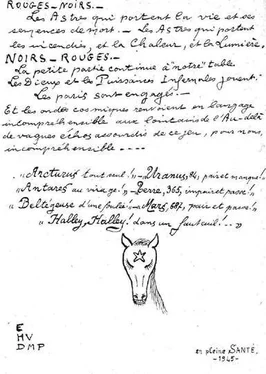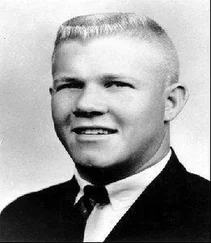Everything seemed so peculiar, so disturbing. Marguerite Braunberger knew that her husband was under enormous pressure. Not only did he fear arrest, but a new law was about to remove his right, as a Jew, to practice medicine. But he would not leave her that way, without the slightest hint of planning and certainly not without a good-bye. And he would never confuse her pet name.
Why, too, of all his family, friends, and patients, would he choose to write to Raymond Vallée, a man whom he did not know well and, moreover, never really liked? The two families had met socially because Marguerite Braunberger was a close friend of Raymonde’s wife, Paulette, and the women had insisted on it.
As they tried to figure out what was happening, Vallée received another letter on June 24, with a stranger request:
My dear friend
,
I know that your cousin, the doctor, bought a house near the Bois de Boulogne in which he does not intend to live until after the war. Would you do me the service of making arrangements with him to have all my furniture and property moved to his house? I am counting on your help. Please have this done within forty-eight hours. Thank you
.
Vallée was certain that he had never mentioned such a house to Braunberger and could not understand how he could have known about it. As for his “cousin the doctor,” Vallée had no such relative. His wife’s cousin, on the other hand, was married to Marcel Petiot.
The Vallées, the Braunbergers, and the Petiots had met one evening before the disappearance. Madame Braunberger could barely remember the occasion some thirteen years before, calling it “a baptism or first communion of the Vallée child.” There in the Vallée salon, Dr. Braunberger and Dr. Petiot had discussed many things, from cancer treatments to antique furniture.
After the party, Braunberger had told his wife that Dr. Petiot was “either a genius or a madman.” Was this meeting why Vallée was selected to receive the letters? He was the only person known at that time who could be traced back to both Petiot and Braunberger. (Actually, there was another connection that the police had not yet found: one of Braunberger’s patients was the makeup artist Edmond Pintard.)
This was admittedly an odd case. Unlike the other disappearances, Braunberger was not about to testify against Petiot and he carried no jewels or fortune with him; the killer would have earned little from such an enterprise. Perhaps this explains the requests for transporting the physician’s property.
About one in the afternoon on June 30, the Braunbergers received an anonymous telephone call. When the nurse at the doctor’s practice, Marie-Cécile Callède, answered, a man on the line immediately launched into the details of Braunberger’s fate: “I’m going to give you news of the doctor. I guided him through to the Free Zone but he went a little nuts. In the métro, he already began to act strange and at the border he nearly caused our arrest. Let Madame take care of herself as best she can. I will not guide her through. I have been too poorly paid.” All of this was spoken as if it were being read from a sheet of paper.
Asked about Braunberger’s health and whereabouts, the man said that he was on his way to Spain and Portugal. The nurse pressed for details and tried to coax the caller over to the apartment with the offer of a reward, but he refused. He said only that he had another letter, which he was supposed to deliver but preferred to put in the mail. He didn’t say anything else, other than mention that Braunberger’s brother, Marcel, would be well advised to leave Paris too.
The letter arrived the following day, sent from the post office at quai Valmy, not far from the Braunbergers’ apartment. Using the same, if incorrect, pet name for Dr. Braunberger’s wife, it was a short, undated note on ordinary white paper instructing Madame Braunberger to “follow the person who brings you this letter.” He promised that they would meet soon and wished her “all my love,” again using unusual phrases and signing the letter, uncharacteristically, with his title, Dr. Paul Braunberger.
Madame Braunberger had not heard anything else, either by letter or telephone. But, on July 3, a young man in a Nazi uniform identifying himself as “German Police” visited her building and inquired about a doctor who had previously served as a medical captain in the First World War and now owned a private practice. The concierge said no one fitting that description lived there, which, given Braunberger’s recent disappearance, was technically not incorrect. The man left. She never learned the purpose of the visit.
The police never determined if this was in fact a real German soldier or another imposter. At any rate, whatever the purpose of the visit, Madame Braunberger did not immediately report her husband’s disappearance. The timing of the visit was curious, coming, as it did, just one month after Petiot escaped damage from the narcotics cases with no more than a token fine.
Reporting the case of Dr. Braunberger to the authorities would not have done a lot of good anyway. Jews in Occupied Paris had no formal legal recourse, and Madame Braunberger certainly could not count on any sympathy from authorities. She had kept quiet for another three months, when finally, on September 25, 1942, at the maid’s insistence, she reported her husband’s disappearance to the police station at Saint-Vincent-de-Paul. At that point, she felt she had nothing to lose. The police officer on duty filed a report. The case was closed on January 9, 1943, on the tragically incorrect grounds that Braunberger had returned home.
22.
AT SAINT-MANDÉ-TOURELLE STATION
WHEN YOU KNOW WHERE THE APPLE IS PICKED, IT IS ENOUGH TO WAIT FOR IT TO FALL FROM THE TREE.
—Commissaire Lucien Pinault
“THE Mad Butcher was no Nazi propaganda myth,” United Press foreign correspondent Dudley Ann Harmon wrote on August 31, 1944. He was “a swarthy, sinister-looking [man] with the sadistic features of a Krafft-Ebing nightmare and the cleverness of a scientist.” The Liberation of Paris had finally put to rest the rumor that Petiot was a Gestapo fabrication. As one policeman remarked, he wished the murderer had been a myth: “He is only too real. We have identified 54 victims, and heaven only knows how many more there are.”
Paris-Soir was also estimating that the total number of victims was probably about fifty. Parisians, however, continued to attribute new murders to the serial killer. One anonymous letter accused Petiot of slitting the throat of a twenty-nine-year-old Italian woman named Laetitia Toureaux on a train on May 16, 1937—the first murder on the French métro. Another suggested that he planted the bomb that killed socialist minister of the interior Max Dormoy in late July 1941, and a third one claimed that he killed Carlo and Nello Rosselli, two anti-fascist Italian refugees, near Bagnoles-de-l’Orne, receiving payment of one hundred semiautomatic guns from Benito Mussolini. Each of these allegations was far-fetched, and the murders showed few, if any, of the characteristics that the police ascribed to the assassin of rue Le Sueur. A more likely suspect, in every one of these cases, would later emerge: a French fascist group, CSAR (Secret Committee of Revolutionary Action), known informally as La Cagoule, or the “hooded ones.”
As Paris was transforming itself again in the autumn of 1944, the French police were still no closer to finding Petiot. Perhaps he had fled to Germany with retreating Nazis, as many people believed, the New York Times reported. Other newspapers, like La patrie , suspected that Petiot had remained in Paris. Sightings of the murder suspect were again on the rise.
Читать дальше












